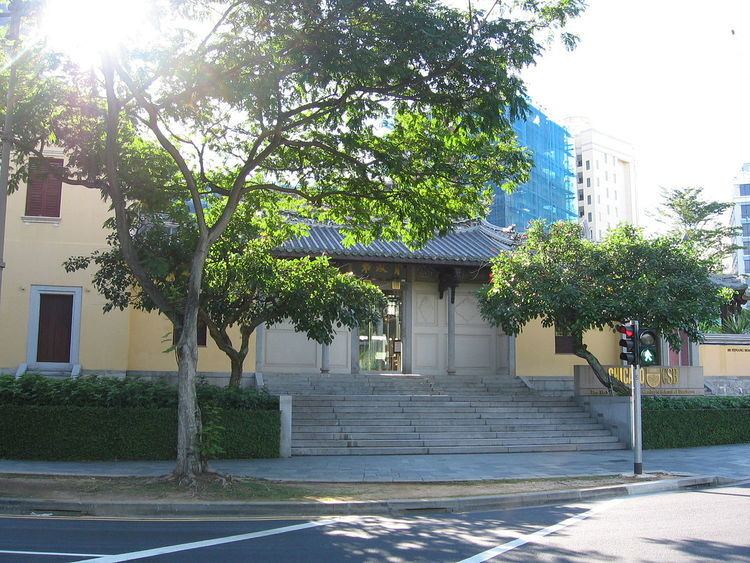 | ||
Address 101 Penang Rd, Singapore 238466 Similar Chesed‑El Synagogue, Hong San See, Tan Si Chong Su, Masjid Hajjah Fatimah, Former Thong Chai Med | ||
Aha 2001 winner 101 penang road former house of tan yeok nee
The House of Tan Yeok Nee (Chinese: 陈旭年宅第 or 陈旭年大厦) is a mansion building located at the corner of Penang Road and Clemenceau Avenue in the Museum Planning Area in Singapore. Today, the building is being used as the Asian campus for the University of Chicago Booth School of Business.
Contents
History
The mansion belonged to Chaozhou-born businessman Tan Yeok Nee who built it in 1885. It is the only survivor of the Four Mansions (四大厝) built in the late 19th century. Tan Yeok Nee was born in 1827. To escape poverty in his village, he came to the region of Southeast Asia then known as Nanyang where he traded textiles. Later, he planted pepper and spices in Johor and became a port owner. In addition, Tan joint ventured with another Teochew tycoon, Tan Seng Bo, and Chang, a Hoklo (Hokkien) leader, in the then legal opium and liquor trades. Three years later, Tan Yeok Nee immigrated to Singapore, where he built this "House of Administration". He soon amassed a great fortune through his involvement with his trades and the ownership of lucrative property.
Tan's house is one of two surviving examples of traditional Chinese mansions in Singapore; the other is River House in Clarke Quay. Tan lived in this mansion for most of his life; he died in China at age 75. He outlived his sons and the house was left to his eight grandsons.
At the turn of the 20th century, when the Singapore-Johor Railway was being built, the house was acquired for use by the Tank Road Station master. Within a decade, the government granted Tan's house to the Anglican Church, which established St Mary's Home and School for Eurasian Girls in 1912.
On 28 May 1938, the Salvation Army established their headquarters in Tan's house. The house remained the Salvation Army's centre of operations for over 50 years, with the exception of the war years, during which the Japanese controlled it.
After the war, it was found shattered and torn to pieces by repeated bombing and looting. S$86,000 was spent on repairs and rebuilding over the next few years.
In July 1951, it was officially reopened by Governor Sir Franklin Gimson. Forty years later in 1991, the Salvation Army's headquarters was relocated to Bishan and the house was sold to the Cockpit Hotel. The House of Tan Yeok Nee has since been purchased by the Wing Tai Group, which invested S$1.2 million for its restoration. The building is now occupied by The University of Chicago Booth School of Business as its Asian campus.
The House of Tan Yeok Nee was gazetted as a national monument on 29 November 1974.
Architecture
The House of Tan Yeok Nee occupies approximately 2,000 square metres of elevated land along Clemenceau Avenue. The mansion has been carefully restored with great sensitivity to ensure that the original architecture and character of the house is kept intact. The walls, tiles, roof, pillars, carvings and pottery were restored to their original state of a century ago through painstaking research.
However, contemporary facilities and equipment have also been incorporated to adapt the building for modern day usage. With the wide array of beautifully restored traditional Chinese decorative elements and the convenience of present-day state-of-the-art technology around the house, this combination of 'old' and 'new' provides a unique environment rich in history and culture.
The front and back portions of the house face east and west. Pillars on the front door are made of marble with colourful carvings of stories reflecting the lives of Tan Yeok Nee’s ancestors in Chaozhou. The back of the house has a distinctive style exhibited by beams with special Teochew tiles, a main pillar decorated with gold-plated carvings, and a marble floor. Exquisite, colourful tiles reflect Chinese people characters and animals.
The House of Tan Yeok Nee is typical of Teochew-style residential buildings. The structure exhibits the harmony of Yin and Yang, shown at the top of the ceiling in gold, wood, water, fire, and earth – the five elements. Armed with traditional philosophical ideas, the designer coordinated the entire building’s design to reflect the balance and harmony represented by the five elements. This unique design not only enriches the artistic value of the walls, but also represents the unity of prosperity, intelligence, longevity, health and happiness.
